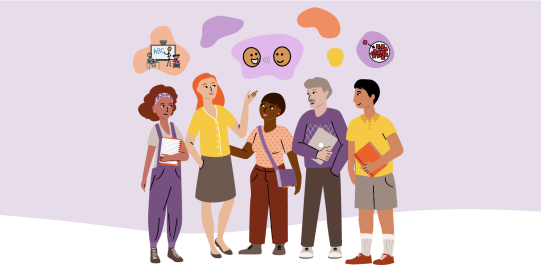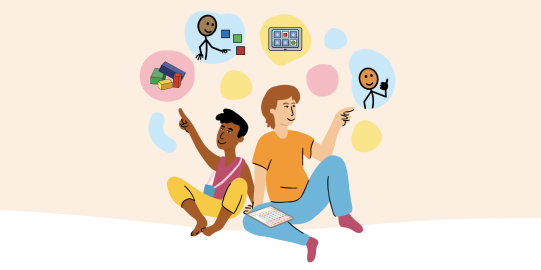Educational goals in IEPs
The most common place to find goals for school-aged learners is in their Individualized Education Plan (IEP). An IEP is a legal document that outlines the additional support and accommodations a student receives in school in the United States. The IEP also captures each student’s current skills in a section titled “Present Level of Academic Achievement and Functional Performance (PLAAFP).” This portion of the IEP serves as a baseline to guide the rest of the IEP planning, including what goal areas will be addressed for the next 12-month period. These may include academic goals, communication goals, safety, and self-care. The common thread is that each IEP goal must support that student’s specific needs, be linked to learning the curriculum, and relate to their role as a learner in the school setting.
Writing better goals for AAC learning
The communication goals for students using AAC may directly target AAC skills (such as operating their device) or target specific language areas. Sometimes, communication goals are not structured in a way that leads to expanding communication but to a specific task. Here are four things to keep in mind when writing IEP goals for someone learning to use AAC.
1. Measure observable communication rather than mastery
It is common for speech and language goals to target 80% accuracy on a specific task or skill. But consider that when working on early communication skills, it’s often inappropriate to write goals requiring a student to perform a skill on 8 out of 10 opportunities.
For example, an accuracy-based goal might say:
“Student will use the phrase, “I want __(food or drink)_” when they are hungry or thirsty on 8/10 opportunities.”
But let’s think about this.
While we can create opportunities by making food or drink available, we don’t know whether a child is really hungry or thirsty. If they do not request an item, how do we know if it was an “error” or if they just weren’t thirsty? They may understand the skill but not demonstrate it when an adult expects them to.
Goals have to be measurable, but the measure of success does not need to be “accuracy.” Consider other observable signs that are meaningful to that individual. Some examples of observable communication behaviors that you can measure include:
- The amount of time a student remains within the proximity of AAC modeling & instruction
- The amount of time a student stays engaged as an adult or peer uses AAC
- The number of times they seek out an adult with AAC
- The number of times they look at, reach, or tap the screen of an AAC system.
Think about what type of engagement is observable, skills that can be supported through targeted practice, and opportunities that can be measured over time.
2. Measure progress over time
Goals are typically designed to cover a year of learning and progress, with incremental progress reported at marking periods. It is common for IEP teams to gather updated data on goals when progress reports are due. To do this, school teams often test students to see if they’ve achieved that goal. Remember that testing a targeted skill at a specific time, using a manufactured opportunity, may not reflect the actual understanding and growth of the student. It may be hard to see incremental gains when measuring a student’s ability in a single moment.
Instead, IEP goals can capture growth through an observational period. When creating goals, the IEP team gets to decide the time frame attached to the metrics. For example, the conditions for mastery could be:
“Student will initiate a greeting with a peer three times over two weeks of documented observations,” or
“Student will explore their AAC vocabulary as evidenced by activation of at least 40 unique words over the course of four weeks.”
The duration of a reporting period varies based on the student, the environment, and the specific skill that’s being measured. Remember that various members of the IEP can support data collection on goal progress. Perhaps there’s a monthly tally sheet in the classroom, and staff jot down a note when they see that skill throughout the day. Spreading out the measurement period encourages broader carryover and implementation.
3. Address patterns that we’d like to see rather than one specific skill
Sometimes, we write ourselves into a corner by creating highly specific IEP goals.
Consider goals that build on a broad set of skills, such as a communication function. For example:
Narrow goal: “Student will use the word, “like” to indicate preference or enjoyment.”
Broad goal: “Student will express opinions in response to people, activities, or objects throughout their school day.”
This broader goal allows for more opportunities to practice the skill of “expressing opinions.” It also recognizes that a student may comment on more than positive opinions, such as “like.” They might want to say something is “gross,” “bad,” or “stinky.” These are also valid opinions and provide motivating opportunities to many students.
4. Embed the conditions that a student needs to be successful
To give students the best chance of success, we need to ensure they’ve had ample time to learn about AAC and targeted language skills. This means giving the student time to observe a new skill and participate in explicit language instruction. Over time and exposure, students build their language skills and learn when and how symbols are used.
IEP goals need to be written to ensure the student is provided with sufficient learning opportunities. One way to do this is to add the conditions required for a goal to be mastered. What does the student need in order to have ample opportunities to practice this skill? These conditions for learning or ‘condition statements’ often fit at the beginning of a goal. For example:
“Given daily core vocabulary instruction during literacy centers, student will independently use at least four core words throughout the school day.”
Other possible condition statements include:
- Given unrestricted access to AAC systems…
- Following staff modeling by attributing meaning…
- Provided with daily demonstration of novel AAC use…
- After providing peer-led opportunities to engage with AAC…
When goals are nested within the conditions they need to thrive, the IEP team has extra assurance that those supports are clearly listed for any team member who targets these goals.
Share with your IEP Team
If there are additional considerations you’d like to embed into your students’ IEPs, talk to the IEP team about it. It’s not uncommon for schools to have preferred ways they like to see goals written. But remember, IEP goals are designed to be relevant and individualized to each student. As you think about new ways to target AAC goals, talk to your IEP team about what this goal will look like in action.
While the IEP process may be unique to some parts of the world, the need for establishing goals is universal. Whether in the schools or a clinical setting, these ideas are designed to support meaningful AAC learning all year.




